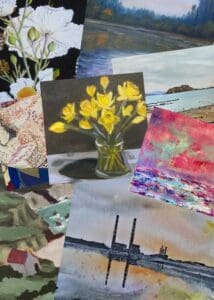When an artist paints with a great array of tubed colors, it can become a chaotic nightmare; especially, when they are trying to achieve harmony. It takes less understanding of how to paint with a few colors mixed properly than to try to manipulate the massive amounts of factory produced paints, not to mention the extra costs involved.
For example, have you ever wondered how all the Dutch masters seemed to create such harmony in their paintings? When you study the work of Rembrandt van Rijn, or a Jan Vermeer, you get goosebumps realizing that these artists knew something that many of the artists today do not know, or do not practice. They understood harmony and how to create it in their paintings.
Harmony is something you see, you feel, and you totally understand when you study it. Painting it, however, is something completely different. Basically, it is created by an artist deciding on a particular color scheme and using a limited palette. You could almost say that the more limited the palette, the more harmony in the picture.
The master artists understood color, hue, temperature, chroma, and value, and knew how to place the pigments onto their canvas (board, or whatever substrate) with meticulous care. Many of them also made and mixed their own colors, and painted with a very few of these. For example, many of Rembrandt’s palettes only consisted of shades of umber, ochre, white, black, and red. How simple is that?
Of course, it’s unfair to try to relate to the great artist of old as if they painted the only way an artist should paint. The playing field is not equal. They didn’t have the many choices of tubed colors we have today. When you realize it wasn’t until the early 1800s that a variety of different colors became available, then you understand artists before this time had to work with what they had. Because of this, it was the limitation of the palette that created such harmonious paintings.
This takes practice, but you can learn to mix all the colors needed for your next masterpiece with only a handful of paints. You can learn to limit your palette. You can actually learn to mix the exact color, color temperature, hue, chroma and value that you desire with the three basic colors (red, yellow, and blue), plus white and black (or a green dark enough when mixed with red to make a black).
When mixing your colors, remember that it’s easier to cool a color down than to warm it up. Start with the lightest color and mix the darker color in a dab at a time. If you want your painting to be interesting and your colors fresh, don’t over mix the colors. Cardinal rule: Do not mix different manufacturing brands. Find a good brand that you prefer and stick with it.
Consider the following reasons why you should become a mix master:
- It saves money. You don’t have to deal with or buy as many tubes of paint.
- It is easier than trying to manipulate the many ranges of tube paints available.
- you can mix colors with a greater selection. You can create the exact color, hue, and value that you desire.
- Everything is less complicated. Your paint case is less cluttered with paint tubes.
- You can prepare your palette in less time.
- It is less difficult to create harmony in your painting.
- As an artist, you will feel more in control of your work.
In conclusion, if you are attempting to create more harmony in your painting, then challenge yourself to learn everything you can about working from a limited palette. This will require you to have an understanding of color and color mixture. Whatever you do, listen to your creative urges, keep experimenting, and work to incorporate your knowledge of colors with all your artistic ideas.
Source by Richard D Burton
Disclaimer: The views and opinions expressed in this article are those of the authors and do not necessarily reflect the official policy or position of Irish Artmart.




